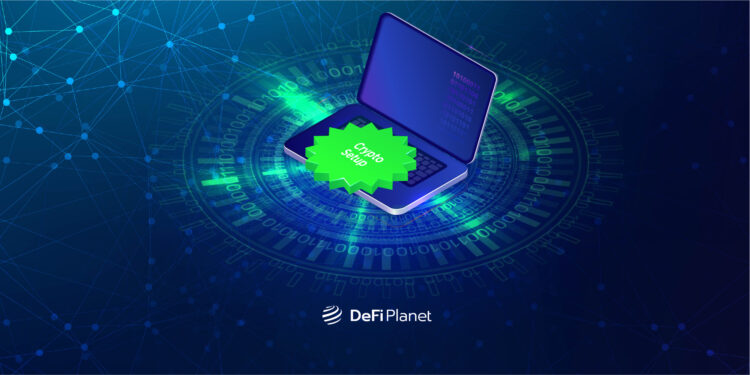Last updated on March 4th, 2025 at 07:26 am
Introducing your child to crypto is such a boss move to set them up for success in the future. In addition to helping them learn important financial skills like saving, budgeting, and investing, you also get to help them understand the DeFi world, how cryptocurrencies work, and prepare them for the new paradigm shift in the financial world. The first step on that journey is setting up a crypto wallet for your child.
And in this guide, we’ll show you how to set up a crypto wallet for your child and help them start their journey into the world of digital finance
Choosing the Right Crypto Wallet for Your Child

Crypto wallets are the passports to access the crypto space. They offer owners a way to store and manage their digital assets. When setting up a crypto wallet for your child, it’s important to choose one that fits their needs and provides a safe and educational experience. Here are some other key factors to consider when this decision:
Legal Requirements
Laws regarding cryptocurrency ownership vary by country. In the U.S., minors can own crypto if managed by a parent or guardian, though they must be 18 to buy and sell it directly. Parents should check local regulations to ensure compliance with age restrictions and crypto ownership guidelines.
To stay compliant, use wallets and exchanges that follow anti-money laundering (AML) and know-your-customer (KYC) rules. Parents should set up the wallet under their name to retain control. Be aware of tax implications, as crypto gains may be taxable.
When choosing a wallet, opt for one with parental controls, like MetaMask, Coinbase Wallet, Trust Wallet, or BlockFi. These allow parents to set limits, monitor transactions, and lock access until a certain age. These features help kids learn about crypto safely while parents guide them through responsible usage.
Security
The security of a crypto wallet is crucial, especially when it involves children’s funds. Look for wallets with strong encryption, two-factor authentication (2FA), and backup options. A good wallet should allow parents to set up a secure recovery process so that even if the child loses access, the funds can be restored. Cold wallets (hardware wallets) are also an option, offering extra security by keeping private keys offline, though they are less user-friendly than hot wallets (software wallets).
Supported Cryptocurrencies:
Ensure that the wallet supports popular and stable cryptocurrencies, such as Bitcoin, Ethereum, or stablecoins like USDC or DAI. Stablecoins are a great option because they are pegged to a real-world asset (like the US dollar), minimizing the price fluctuations that are common with other cryptocurrencies. This could be a safer option for beginners, including children, as it reduces the risk of losing value quickly.
Ease of Use:
Choose a wallet that is easy to navigate for both you the parents and children. The interface should be simple, clear, and intuitive. Your child should be able to check their balances, make transactions with a few steps and not a complicated process. Look for wallets that provide an easy setup process, minimal jargon, and straightforward educational resources to help your child understand how crypto works.
Step-by-Step Guide to Setting Up a Crypto Wallet for Your Child

Step-by-Step Guide to Setting Up a Crypto Wallet for Your Child
- Step 1: Choose the Right Platform
- Step 2: Create an Account
- Step 3: Set Up a Wallet
- Step 4: Fund the Wallet
- Step 5: Teach Your Child About Safe Usage
Step 1: Choose the Right Platform
The first step in setting up a crypto wallet for your child is to select a trusted platform. Many platforms offer user-friendly crypto wallets that can be managed by parents and used safely by children. Popular options include MetaMask, Coinbase Wallet, Trust Wallet, and BlockFi, which provide a balance of security, ease of use, and features suitable for beginners.
Make sure the platform you choose has strong security measures in place. Look for platforms with good reviews, secure encryption, and support for the cryptocurrencies you plan to use, such as Bitcoin, Ethereum, or stablecoins.
Step 2: Create an Account
Once you’ve chosen the platform, you’ll need to create an account. You may need to sign up using your own credentials as a parent to manage the wallet. This usually involves entering your email, creating a password, and completing a security verification.
You’ll likely be asked to set up two-factor authentication (2FA) for added security, which ensures that only authorized users can access the account. An email verification process will also confirm your identity and validate your account, providing extra protection for both you and your child.
Step 3: Set Up a Wallet
Next, it’s time to set up the wallet itself. You’ll typically have the option to choose between a hot wallet (connected to the internet and managed by centralized exchanges) or a cold wallet (offline storage). Hot wallets are more convenient for frequent transactions but are more vulnerable to hacking, while cold wallets offer enhanced security but are less accessible.
After selecting the type of wallet, you will go through the setup process, which often includes creating a recovery phrase (a series of words used to restore the wallet if you lose access) and setting a strong password. Keep the recovery phrase secure and do not share it with anyone, as it gives full access to the wallet’s contents.
Step 4: Fund the Wallet
Once your wallet is set up, it’s time to fund it. You can transfer funds into the wallet by purchasing cryptocurrency from an exchange like Coinbase or Kraken and then sending it to your wallet’s address. Alternatively, if you already have crypto in another wallet, you can transfer it to the new wallet.
When funding the wallet, it’s important to understand that there may be transaction fees, which vary depending on the cryptocurrency and platform. Some wallets also have minimum deposit amounts, so check the requirements before making a transfer. For children, it may be best to start with stablecoins, like USDT or USDC, which are less volatile and can help avoid big price swings.
Step 5: Teach Your Child About Safe Usage
The final step is to teach your child how to use the wallet safely. Explain the importance of security, such as keeping the private key and recovery phrase private and never sharing them with anyone. Encourage them to choose strong passwords and help them understand why they should never share wallet details or passwords online.
You can also set up parental controls and transaction limits within the wallet to help guide your child’s spending and limit risks. By establishing these boundaries and educating your child about digital asset security, you can ensure they use the wallet responsibly while learning about cryptocurrency in a secure and controlled environment.
Best Practices for Crypto Wallet Management for Children
Managing a crypto wallet for children requires a combination of security, education, and responsible oversight. By following best practices, parents can ensure their children’s digital assets are safe while teaching valuable lessons in financial literacy.
Security Tips
When managing a crypto wallet for children, security is key. The most important information to protect is the private key and backup phrase, which are needed to access the wallet. Store them in a safe place that only you, as the parent, can access. Do not share these with anyone, including your child.
For added protection, consider using multi-signature wallets, which require approval from more than one person (e.g., both you and your child) to authorize transactions. You can also enable two-factor authentication (2FA), which adds an extra layer of security when logging in, such as a code sent to your phone.
Setting Limits and Restrictions
To help your child use cryptocurrency responsibly, set clear spending limits and restrictions. Many crypto wallets allow you to set daily or weekly spending caps to prevent overspending. You can also enable transaction alerts, so you’re notified every time money moves in or out of the wallet.
Encourage your child to save and invest wisely. Teach them to allocate funds for saving or investing and explain the importance of not spending all their money. It’s also useful to show them how the value of cryptocurrencies can change, which will help them make smarter decisions.
Monitoring the Wallet
Monitoring your child’s wallet activity is important to ensure everything stays secure. Some wallets, like Coinbase and Trust Wallet, offer features that allow parents to view transactions and balances. There are also apps, such as CoinTracking, that help you keep track of their assets and activities.
It’s a good idea to regularly talk to your child about their investments and what’s happening in the crypto market. Help them understand the risks and guide them in making informed decisions. By staying involved, you can teach them how to manage their cryptocurrency safely and responsibly.
Final Thoughts
Crypto education shouldn’t end with wallet setup. It should be approached with a focus on long-term learning and responsible management. Regularly check in on your child’s progress, discuss market trends, and address any questions they might have. This active involvement fosters both financial literacy and a stronger understanding of the digital economy.
Remember, the goal isn’t just to teach kids about crypto—it’s to instill lifelong financial habits. With the right tools, guidance, and mindset, your child can develop a strong foundation in managing money in the digital age and become informed participants in the growing world of cryptocurrency.
Disclaimer: This article is intended solely for informational purposes and should not be considered trading or investment advice. Nothing herein should be construed as financial, legal, or tax advice. Trading or investing in cryptocurrencies carries a considerable risk of financial loss. Always conduct due diligence.
If you would like to read more analyses like this, visit DeFi Planet and follow us on Twitter, LinkedIn, Facebook, Instagram, and CoinMarketCap Community.
Take control of your crypto portfolio with MARKETS PRO, DeFi Planet’s suite of analytics tools.”





















